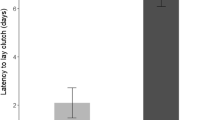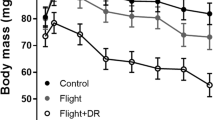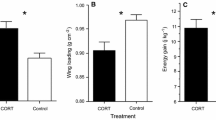Abstract
Conditions experienced in early life have been shown to affect the development or programming of physiological processes. While animals may recover from earlier periods of adversity, this process can carry long-term costs. Such long-term effects are likely to be most evident when individuals are placed in demanding situations that require high performance. Escape flight speed in passerine birds is crucial to predator evasion and requires very rapid take-off. Here, we examine whether the ability to maintain escape flight performance during the immediate post-breeding period is influenced by conditions in early life. We manipulated the early life conditions experienced by zebra finches (Taeniopygia guttata) by rearing them on either low or high quality food through the growth period, or by changing conditions halfway through the nestling period, moving from high to low or vice versa. While there was no difference amongst the treatment groups in body size attained by adulthood, amongst the birds that experienced low quality food, the body size of those that were switched to a high quality diet halfway through the nestling growth period recovered faster than those that had low quality food until fledging. We found no differences amongst the dietary groups in flight performance at adulthood prior to breeding, and all groups showed a decline in average escape flight performance over the breeding period. However, the magnitude of the post-breeding decline in flight performance for a given level of reproductive output was significantly greater for those females that had experienced a switch from a low to a high quality diet during the nestling phase. These results suggest that this diet-induced rapid recovery of body size, which may have immediate competitive advantages, nonetheless carries locomotory costs in later life manifest in the capacity to sustain the high performance escape response during the post-reproductive recovery phase.



Similar content being viewed by others
References
Álvarez D, Metcalfe NB (2005) Catch-up growth and swimming performance in threespine sticklebacks (Gasterosteus aculeatus): seasonal changes in the cost of compensation. Can J Fish Aquat Sci 62:2169–2176
Álvarez D, Metcalfe NB (2007) The trade-off between catch-up growth and escape speed: variation between habitats in the cost of compensation. Oikos 116:1144–1151
Arendt JD (2003) Reduced burst speed is a cost of rapid growth in anuran tadpoles: problems of autocorrelation and inferences about growth rates. Funct Ecol 17:328–334
Arnott SA, Chiba S, Conover DO (2006) Evolution of intrinsic growth rate: Metabolic costs drive trade-offs between growth and swimming performance in Menidia menidia. Evolution 60:1269–1278
Barker DJP (1998) Mothers, babies and health in later life. Churchill Livingstone, Edinburgh
Bateson P, Barker D, Clutton-Brock T, Deb D, D’Udine B, Foley RA, Gluckman P, Godfrey K, Kirkwood T, Lahr MM, McNamara J, Metcalfe NB, Monaghan P, Spencer HG, Sultan SE (2004) Developmental plasticity and human health. Nature 430:419–421
Billerbeck JM, Lankford TE, Conover DO (2001) Evolution of intrinsic growth and energy acquisition rates. I. Trade-offs with swimming performance in Menidia menidia. Evolution 55:1863–1872
Bize P, Metcalfe NB, Roulin A (2006) Catch-up growth strategies differ between body structures: interactions between age and structure-specific growth in wild nestling Alpine swifts. Funct Ecol 20:857–864
Blount JD, Metcalfe NB, Arnold KE, Surai PF, Monaghan P (2006) Effects of neonatal nutrition on adult reproduction in a passerine bird. Ibis 148:509–514
Chin EH, Love OP, Verspoor JJ, Williams TD, Rowley K, Burness G (2009) Juveniles exposed to embryonic corticosterone have enhanced flight performance. Proc R Soc Lond B 276:499–505
Cleal JK, Poore KR, Boullin JP, Khan O, Chau R, Hambidge O, Torrens C, Newman JP, Poston L, Noakes DE, Hanson MA, Green LR (2007) Mismatched pre- and postnatal nutrition leads to cardiovascular dysfunction and altered renal function in adulthood. Proc Nat Acad Sci USA 104:9529–9533
Costantini D (2008) Oxidative stress in ecology and evolution: lessons from avian studies. Ecol Lett 11:1238–1251
Cresswell W (1993) Escape responses by redshanks, Tringa totanus, on attack by avian predators. Anim Behav 46:609–611
Criscuolo F, Monaghan P, Nasir L, Metcalfe NB (2008) Early development and phenotypic development: ‘catch-up’ growth leads to elevated metabolic rate in adulthood. Proc R Soc Lond B 275:1565–1570
Harshman LG, Zera AJ (2007) The cost of reproduction: the devil in the details. Trends Ecol Evol 22:80–86
Haywood S, Perrins CM (1992) Is clutch size affected by environmental conditions during growth? Proc R Soc Lond B 249:195–197
Houston DC, Donnan D, Jones P (1995a) The sources of nutrients required for egg production in zebra finches Poephila guttata. J Zool Lond 235:469–483
Houston DC, Donnan D, Jones P, Hamilton I, Osborne D (1995b) Changes in the muscle condition of the female zebra finch Poephila guttata during egg laying and the role of protein storage in bird skeletal muscle. Ibis 137:322–328
Kullberg C, Houston DC, Metcalfe NB (2002a) Impaired flight ability -a cost of reproduction in female blue tits. Behav Ecol 13:575–579
Kullberg C, Metcalfe NB, Houston DC (2002b) Impaired flight ability during incubation in the pied flycatcher. J Avian Biol 33:179–183
Langley-Evans SC (2006) Developmental programming of health and disease. Proc Nutr Soc 65:97–105
Lee WS, Monaghan P, Metcalfe NB (2010) The trade-off between growth rate and locomotor performance varies with perceived time until breeding. J Exp Biol 213:3289–3298
Lessells CM, Boag PT (1987) Unrepeatable repeatabilities: a common mistake. Auk 104:116–121
Metcalfe NB, Monaghan P (2001) Compensation for a bad start: grow now, pay later? Trends Ecol Evol 16:254–260
Metcalfe NB, Monaghan P (2003) Growth versus lifespan: perspectives from evolutionary ecology. Exp Gerontol 38:935–940
Monaghan P, Nager RG (1997) Why do not birds lay more eggs? Trends Ecol Evol 12:270–274
Monaghan P, Metcalfe NB, Torres R (2009) Oxidative stress as a mediator of life history trade-offs: mechanisms, measurements and interpretation. Ecol Lett 12:75–92
Munch SB, Conover DO (2004) Nonlinear growth cost in Menidia menidia: theory and empirical evidence. Evolution 58:661–664
Naguib M, Gil D (2005) Transgenerational effects on body size caused by early developmental stress in zebra finches. Biol Letts 1:95–97
Naguib M, Nemitz A, Gil D (2006) Maternal developmental stress reduces reproductive success of female offspring in zebra finches. Proc R Soc Lond B 273:1901–1905
Perfito N, Zann RA, Bentley GE, Hau M (2007) Opportunism at work: habitat predictability affects reproductive readiness in free-living zebra finches. Funct Ecol 21:291–301
Reid JM, Bignal EM, Bignal S, McCracken DI, Monaghan P (2003) Environmental variability, life-history covariation and cohort effects in the red-billed chough Pyrrhocorax pyrrhocorax. J Anim Ecol 72:36–46
Ricklefs RE (2006) Embryo development and ageing in birds and mammals. Proc R Soc Lond B 273:2077–2082
Royle NJ, Lindström J, Metcalfe NB (2006) Effect of growth compensation on subsequent physical fitness in green swordtails Xiphophorus helleri. Biol Lett 2:39–42
Samuels SE, Baracos VE (1995) Tissue protein turnover is altered during catch-up growth following Escherichia coli infection in weanling rats. J Nutr 125:520–530
Sedinger JS, Flint PF, Lindberg MS (1995) Environmental influence on life-history traits: growth, survival and fecundity in black brant (Branta bernicla). Ecology 76:2404–2414
Stearns SC (1992) The evolution of life histories. Oxford University Press, Oxford
Tarry-Adkins JL, Martin-Gronert MS, Chen JH, Cripps RL, Ozanne SE (2008) Maternal diet influences DNA damage, aortic telomere length, oxidative stress, and antioxidant defense capacity in rats. FASEB J 22:2037–2044
Temeles EJ (1985) Sexual size dimorphism in bird-eating hawks: the effect of prey vulnerability. Am Nat 125:485–499
Veasey JS, Metcalfe NB, Houston DC (1998) A reassessment of the effect of body mass upon flight speed and predation risk in birds. Anim Behav 56:883–889
Veasey JS, Houston DC, Metcalfe NB (2000) Flight muscle atrophy and predation risk in breeding birds. Funct Ecol 14:115–121
Veasey JS, Houston DC, Metcalfe NB (2001) A hidden cost of reproduction: the trade-off between clutch size and escape speed in female zebra finches. J Anim Ecol 70:20–24
Zann RA, Morton SR, Jones KR, Burley NT (1995) The timing of breeding by zebra finches in relation to rainfall in central Australia. Emu 95:208–222
Zera AJ, Harshman LG (2001) The physiology of life history trade-offs in animals. Annu Rev Ecol Syst 32:95–126
Acknowledgments
We are grateful to Graham Law, Christine Donaldson, Kate Griffiths, Alister Kirk, San Kim and Dorothy Armstrong for help with bird husbandry, Lubna Nasir for helpful discussions, and two referees for helpful comments on the manuscript. This study was funded by a grant from the Natural Environment Research Council, UK.
Author information
Authors and Affiliations
Corresponding author
Additional information
Communicated by Heli Siitari.
Rights and permissions
About this article
Cite this article
Criscuolo, F., Monaghan, P., Proust, A. et al. Costs of compensation: effect of early life conditions and reproduction on flight performance in zebra finches. Oecologia 167, 315–323 (2011). https://doi.org/10.1007/s00442-011-1986-0
Received:
Accepted:
Published:
Issue Date:
DOI: https://doi.org/10.1007/s00442-011-1986-0




